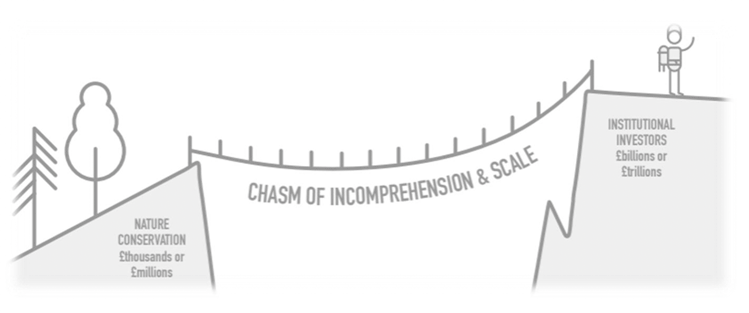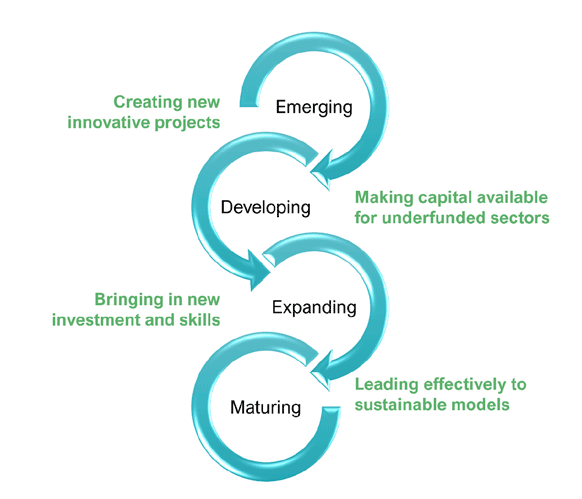Supporting impact - Scottish Crown Estate net revenue: local authority use and insights
Net Revenues from the Scottish Crown Estate have been distributed to coastal Local Authorities for the benefit of coastal communities since 2019. This study was commissioned as part of the review process for the first two rounds of distribution of Scottish Crown Estate net revenues.
Blended finance and investing
Blended finance is an innovative approach that can underpin the principles of leveraging, innovation and bridging. Understanding and applying this framework is one method of achieving scale through net revenue distribution.
There has been considerable innovation in green and sustainable finance in recent years, as organisations try to develop approaches that both generate a return and address the climate and nature emergencies and the UN Sustainable Development Goals. This challenge was articulated in the £1 Billion Challenge Route Map (Figure 2) which noted the existence of a "chasm of incomprehension and scale" between nature and conservation investment opportunities – many of which may be of significant value to coastal communities – and the usual institutional investors.

This is a rapidly changing and relatively immature area of finance with numerous parties exploring ideas. There are several activities taking place in Scotland exploring this potential, with many gathering and sharing ideas through the Scottish Conservation Finance Pioneers, hosted by the Scottish Wildlife Trust. This work is of considerable interest to the use of net revenues and may offer a new pipeline of projects to invest in, or models that can help to get greater scale of impact and return. Ultimately, the use of net revenues could help traverse this chasm of incomprehension and scale, and help unlock the considerable and benefits of these currently difficult-to-fund projects for coastal communities.
One possible method is blended finance, an innovative approach to financing sustainable development that aims to attract commercial capital towards projects that benefit society, while also providing financial returns to investors. Blended finance offers serval benefits, but primarily mobilises additional and external sources of finance for development and de-risks the overall investment. Other benefits are highlighted in Figure 3.

Blended finance has three key characteristics:
- Leverage - use of development finance and philanthropic funds to attract private capital into projects
- Impact - investment that drive social, environmental, and economic progress
- Returns - financial returns for private investors in line with market expectations, based on real and perceived risk
In particular, it may be useful to think of returns in terms of the financial sustainability of a project; a project that can develop a return whilst delivering impact will endure and not need a continuous flow of new funds.
There are also a number of fundamental principles to achieving a blended finance approach that can be adapted to a community project landscape (Table 2). The principles of blended finance developed by the OECD also reflect the foundations of Collective Impact, and indeed the principles of net revenues. This model therefore resonates with the intended purpose of net revenues and brings into view the idea of using net revenues as an investment rather than a grant, or indeed a mix of both.
| Principle 1: Rationale | Blended finance is more effective when it has a strong underlying rationale for investment. |
|---|---|
| Principle 2: Leverage | Blended finance can be used to leverage private finance, through proof of concept, risk reduction or value addition |
| Principle 3: Place-based | Blended finance should be adapted to local approaches, and tailored to fit the needs and gaps of the communities involved |
| Principle 4: Collaboration | Blended finance works effectively with partnering and collaboration across scales |
| Principle 5: Measurement | Blended finance approaches should have transparency and accountability built in, including appropriate monitoring and achievable measurements |
Contact
Email: CESU@gov.scot
There is a problem
Thanks for your feedback